Learning with women innovators, industries and entrepreuneurs¶
| Target group | Colaboration | Objectives |
|---|---|---|
| Alumni, Young Women 25+ | Academy & Community | Explore and Support their Career Paths |
The innovation path addresses women innovators aged 25 and up. It focuses on the possible ‘routes to job’ for women who have been through alternative professional training, ranging from self–made to more traditional career paths. We depart from a research-focused series of actions involving collecting the testimonies of women innovators and exploring the innovation barriers to empower women towards their self made unconventional path.
This learning path is designed to provide a series of activities that can be performed by labs together with their innovators community, in order to create the most enabling environment that the women innovators need to thrive. Find below the roadmap and model that guides the labs and their communities, for each step there is a brief explanation and the link to the activity's example with its main guidelines and tools for replicability.
Formats of the Innovation path¶
Diverse formats are possible for the Innovation Path. In order to better understand the vast range of careers paths, we have brought together alumni and active community members to share with us what their stay in the Lab, the Fabricademy program or other training have brought to them. From their input and vision, we map initial profiles and work towards supporting their needs. This way, the lab can learn how to support the progress of their innovators community members; while developing together and creating awareness among the young women entrepreneurs that surround the labs.
Innovation Path Model¶
The scheme below serves as a general guideline (or roadmap) for a Lab that wishes to improve its abilities when it comes to enabling female innovators on its network. Following a path that delineates new routes to unconventional jobs that reflect the shemakes values and gender vision, through the role and active support of Labs as the enabling environments in which these women innovators can grow and feel supported, connected, empowered.
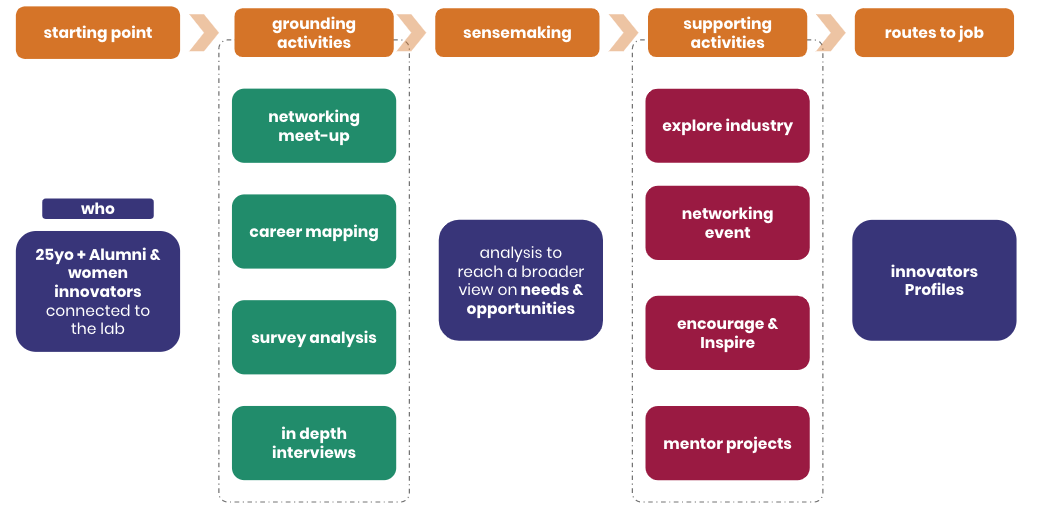
Navigation tip: each activity described below is linked under its correspondent table. They can also be found navigating through the left bar menu
who
Framing your target audience Each Lab should be able to identify who are the innovators community surrounding them. At this moment innovation can be also framed differently for each lab’s context. For certain labs it can translate into high tech research, while for others a new process/way of working that emerges from traditional craft is also innovation.
Grounding activities
Performing activities that gives you a deeper and more meaningful understanding of the women connected to the lab (or the ones you would like to connect with).
Organise and create the space for innovators to meetup Networking meetups mix different alumni from different years, skills and contexts to explore the potential they hold as a growing collective that is active around the labs. The aim is to bring together a heterogeneous group of alumni and innovators creating a new mix while expanding their awareness on the possible routes to job.
Explore the first meetup and networking event in the next section of this Open Toolkit:
Self mapping exercise Alumni/innovators are asked to position themselves on an career matrix for innovators in the Textile & Clothing Sector inspired by profiles we see emerging from Fabricademy and beyond.
Explore the first career matrix and the self-mapping if their career and action field by the innovators themselves in this page:
Launch a research survey In order to gain a broader perspective of needs, gaps, opportunities to support the innovators growth.
Explore our shemakes base survey, the set of questions/areas we explored and it's initial outcomes. The survey is the basis of the research for exploring the needs the innovators voice, the existing gaps to be filled. It sets the direction of the support activities happening next:
Explore together in conversations Understand their specific profiles, their needs and explore how the lab is supporting or/and can further support them.
Explore the format, areas of questions, the full interview setup on the link below:
Together with the survey, the research interviews start portraiying not only the different needs of the innovators/alumni in order to address them, but also create a shared portfolio of example profiles of unconventional routes to job - showing how there is space for many different typologies of innovators within the T&C Industry.
Sensemaking
Understanding and situating the Lab by analyzing all the information collected via the grounding activities. Different innovation profiles might have emerged in the previous phases and for each one of them a specific set of supporting actions are needed.
Supporting activities
By understanding the needs and opportunities in your innovators community you can equip yourself to that action in supporting them to go further. Shemakes' Labs defined the main 4 areas of action as below, for each one of them a detailed material of tools and guidelines can be found.
The initial ideas from the Labs to support their innovators was to assist the innovators into getting to know the industry that surrounds them better, by organizing visits to the (local) ateliers, manufacturers, producers or textile studios.
The initial ideas from the Labs to support their innovators was to create more mixed networking events, were different groups within shemakes can meet and get to know each other.
The initial ideas from the Labs to support their innovators was to help them feel more confident, many innovators expressed the need of being better at presenting themselves, not feeling judged for their gender or choices and be able to pitch their ideas well to different public/audiences.
The initial ideas from the Labs to support their innovators was to assist the innovators to further develop their skills, also technically, for example with tailor made mentoring sessions - in a way learnings can be extracted for other innovators too.
Routes to Job
Innovators Profiles Together with the survey, the research interviews start portraiying not only the different needs of the innovators/alumni in order to address them, but also create a shared portfolio of example profiles of unconventional routes to job - showing how there is space for many different typologies of innovators within the t&c industries.
Shemakes project development - From Core Labs to Transfer Labs¶
In this session we describe the development of the activities that happened during the 2 years of the shemakes project. The intention is by showing the thought process behind the design, execution and reflection of the innovation path, one can better understand the conditions that favoured our outcomes.
The project's activities developed in parallel groups:
- ITERATION 1 Research actions: selfmapping, interviews & survey that lead to the innovators profiles (executed by Core Labs during project's phase 1 and replicated by Transfer Labs in phase 2)
- ITERATION 2 Support actions: new activities that span from the needs defined by the participants of the surveys and interviews (conceptualized by Core Labs during project's phase 1; executed and adapted by Transfer Labs in phase 2)
- Routes to jobs: all labs interviewed 2-3 women innovators that are alumni or active community members that had a unconventional route to job and further expand the mapping of profiles (all Labs phase 1 and 2)
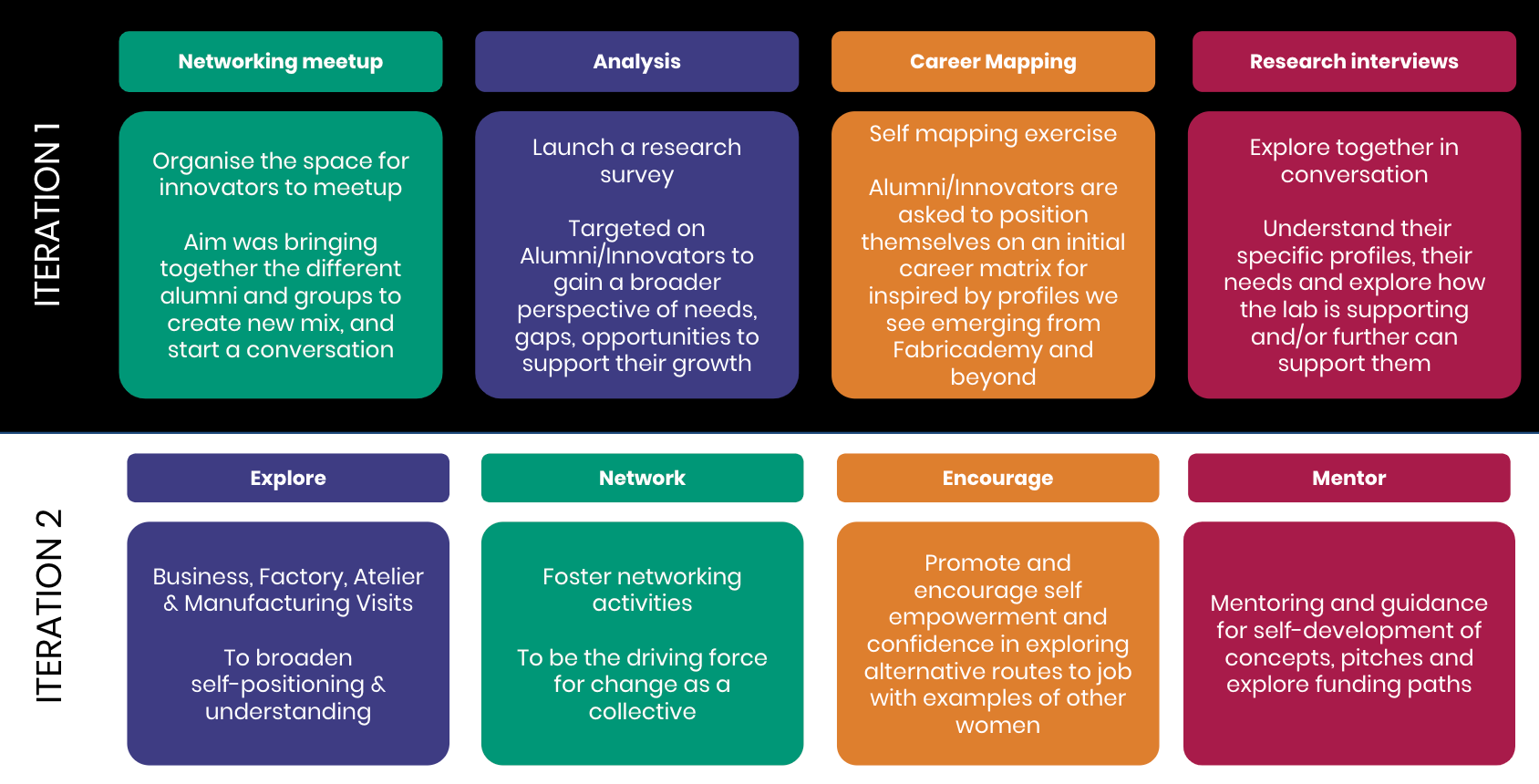
Together they form a path that delineates new routes to unconventional jobs that reflect the shemakes values and gender vision, through the role and active support of Labs as the enbaling environments in which these women innovator can grow and feel supported, connected, empowered.
Initial insighs for documented activities in phase 1¶
 Explore the first meetup and networking event in the next section of this Open Toolkit.
Networking meetups mix different alumni from different years, skills and contextes to explore the potential they hold as a growing collective that is active around the labs.
Explore the first meetup and networking event in the next section of this Open Toolkit.
Networking meetups mix different alumni from different years, skills and contextes to explore the potential they hold as a growing collective that is active around the labs.
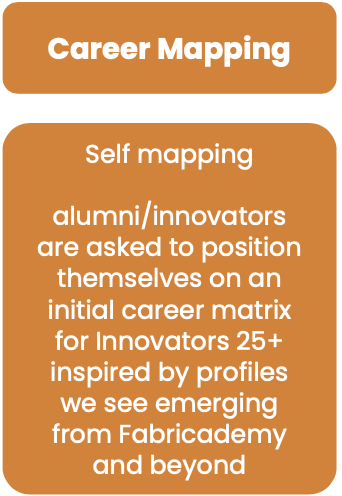 Explore the first career matrix and the self-mapping if their career and action field by the innovators themselves in the next section of this Open Toolkit.
The career matrix is used also in the networking sessions for the innovators/alumni to start self mapping themselves and for us to gain insight on what are their routes to jobs.
Explore the first career matrix and the self-mapping if their career and action field by the innovators themselves in the next section of this Open Toolkit.
The career matrix is used also in the networking sessions for the innovators/alumni to start self mapping themselves and for us to gain insight on what are their routes to jobs.
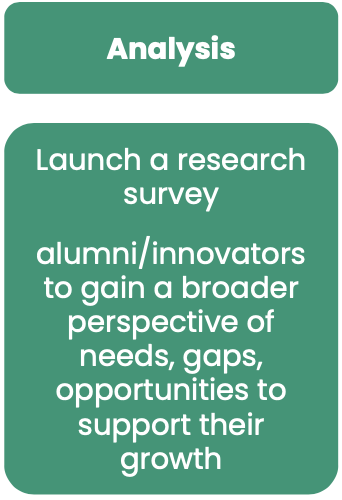 Explore the survey, the set of questions/areas we explored and the initial outcomes of the survey.
The survey is the basis of the research for exploring the needs the innovators voice, the existing gaps to be filled. It sets the direction of the support activities (see chapter below)
Explore the survey, the set of questions/areas we explored and the initial outcomes of the survey.
The survey is the basis of the research for exploring the needs the innovators voice, the existing gaps to be filled. It sets the direction of the support activities (see chapter below)
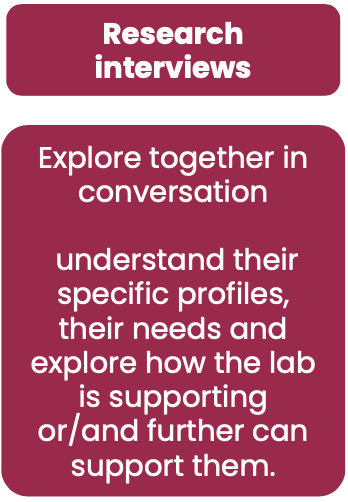 Explore the format, areas of questions, the full interview setup and results of the intervies in the Survey Outcomes and Profile pages.
Together with the survey, the research interviews start portraiying not only the different needs of the innovators/alumni in order to address them, but also create a shared portfolio of example profiles of unconventional routes to job - showing how there is space for many different typologies of innovators within the t&c industtries.
Explore the format, areas of questions, the full interview setup and results of the intervies in the Survey Outcomes and Profile pages.
Together with the survey, the research interviews start portraiying not only the different needs of the innovators/alumni in order to address them, but also create a shared portfolio of example profiles of unconventional routes to job - showing how there is space for many different typologies of innovators within the t&c industtries.
Initial insighs for new activities to be executed in phase 2¶
These areas of activities can be further developed by transfer labs, enriching together the shared set of activities that support the women innovators. They are productive routes to job when in relation to outcomes of a survey or 2-3 innovators research interviews.
 The initial ideas from the Labs to support their innovators was to create more mixed networking events, were different groups within shemakes can meet and get to know each other.
The initial ideas from the Labs to support their innovators was to create more mixed networking events, were different groups within shemakes can meet and get to know each other.
does your initial idea of activities link, support, embody or expand this?
could your intial ideas of activities be fed by 1-2 research interviews to young women innovators? to also add to the profiles mapped?
 The initial ideas from the Labs to support their innovators was to assist the innovators into getting to know the industry that surrounds them better, by organizing visits to the (local) ateliers, manufacturers, producers or textile studios.
The initial ideas from the Labs to support their innovators was to assist the innovators into getting to know the industry that surrounds them better, by organizing visits to the (local) ateliers, manufacturers, producers or textile studios.
does your initial idea of activities link, support, embody or expand this?
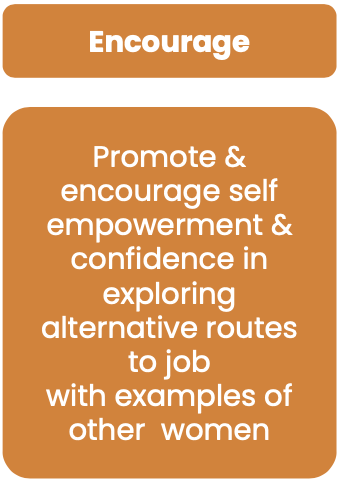 The initial ideas from the Labs to support their innovators was to help them feel more confident, many innovators expressed the need of being better at presenting themselves, not feeling judged for their gender or choices and be able to pitch their ideas well to different public/audiences.
The initial ideas from the Labs to support their innovators was to help them feel more confident, many innovators expressed the need of being better at presenting themselves, not feeling judged for their gender or choices and be able to pitch their ideas well to different public/audiences.
does your initial idea of activities link, support, embody or expand this?
 The initial ideas from the Labs to support their innovators was to assist the innovators to further develop their skills, also technically, for example with tailor made mentoring sessions - in a way learnings can be extracted for other innovators too.
The initial ideas from the Labs to support their innovators was to assist the innovators to further develop their skills, also technically, for example with tailor made mentoring sessions - in a way learnings can be extracted for other innovators too.
does your initial idea of activities link, support, embody or expand this?
Transfer Labs - Project's Phase 2¶
After a first round of research performed by the Core Labs, the Transfer Labs joined the shemakes network and working together we further investigated how to continue shaping the innovation path by replicating certain activities and perfoming new ones.
google slides?!
Action Plan Summary¶
Each lab departs from it's own reality in order to understand how to use and adapt the set of activities that has been co-created in this path. The table below summarizes the choices made by the Transfer Labs in the context of the shemakes' second phase of activities and serves the purpose to inspire other labs to customize the model to their best fit.
